Economic Growth in Australia
VerifiedAdded on 2019/10/31
|22
|4369
|270
Essay
AI Summary
This essay provides a comprehensive analysis of Australia's economic growth from 2012 to 2017. It examines various economic indicators, including Gross National Income (GNI), Gross Domestic Product (GDP), GDP growth rate, GDP per capita, and Purchasing Power Parity (PPP)-adjusted GDP per capita. The essay explores the reasons behind the slowdown in GDP growth, attributing it to factors such as the slowdown in the mining industry (due to decreased demand for mining labor and a shift towards renewable energy), the decline in the housing market (resulting from government regulations on lending), and a decrease in exports (influenced by currency exchange rate volatility). The essay also analyzes the inflation rate, linking it to increased consumption expenditure and the decrease in the unemployment rate. Despite the slowdown in GDP growth, the essay notes a steady increase in GDP per capita and PPP-adjusted GDP per capita. The conclusion summarizes the findings and suggests that Australia has the potential for sustained economic growth with effective government policies.
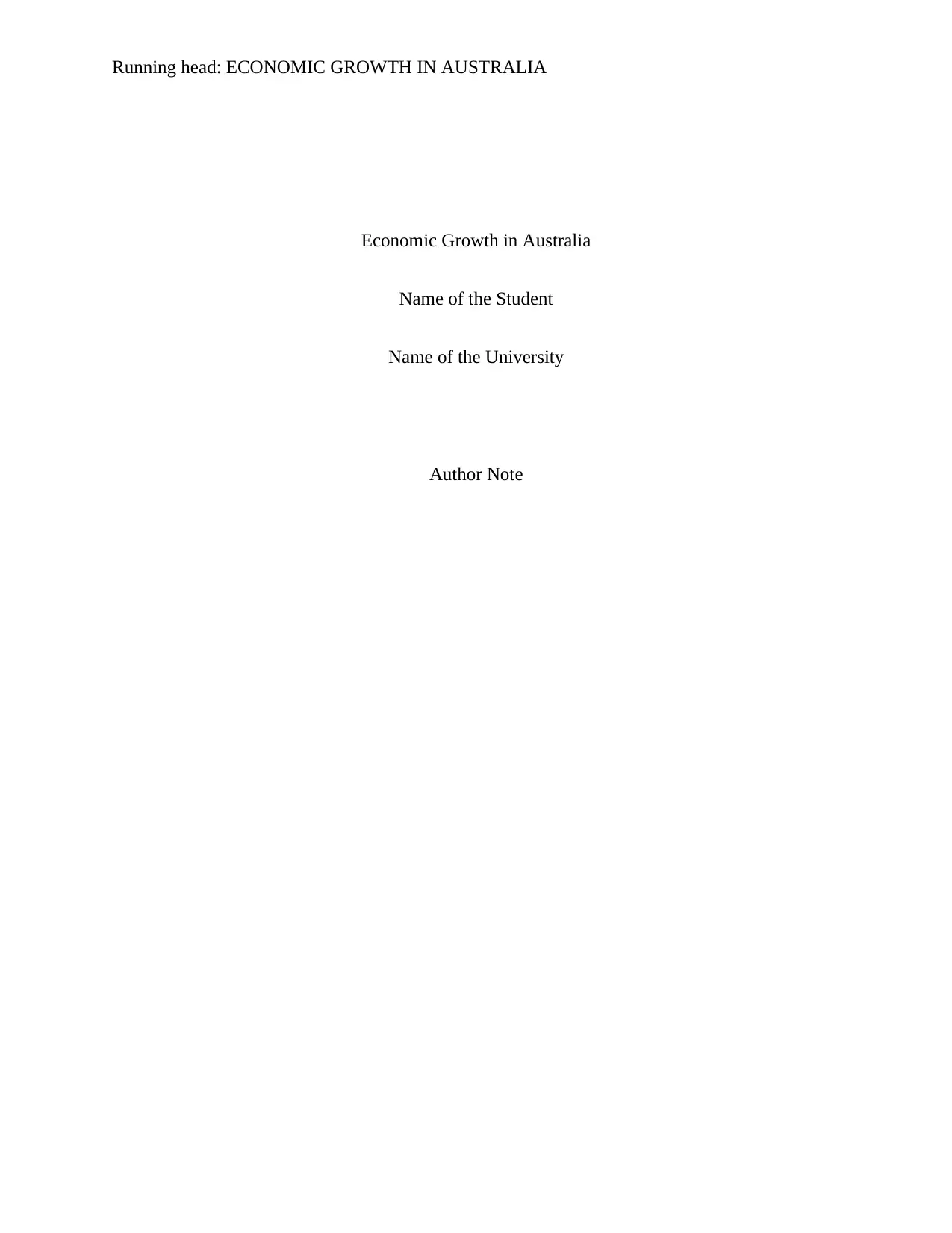
Running head: ECONOMIC GROWTH IN AUSTRALIA
Economic Growth in Australia
Name of the Student
Name of the University
Author Note
Economic Growth in Australia
Name of the Student
Name of the University
Author Note
Paraphrase This Document
Need a fresh take? Get an instant paraphrase of this document with our AI Paraphraser
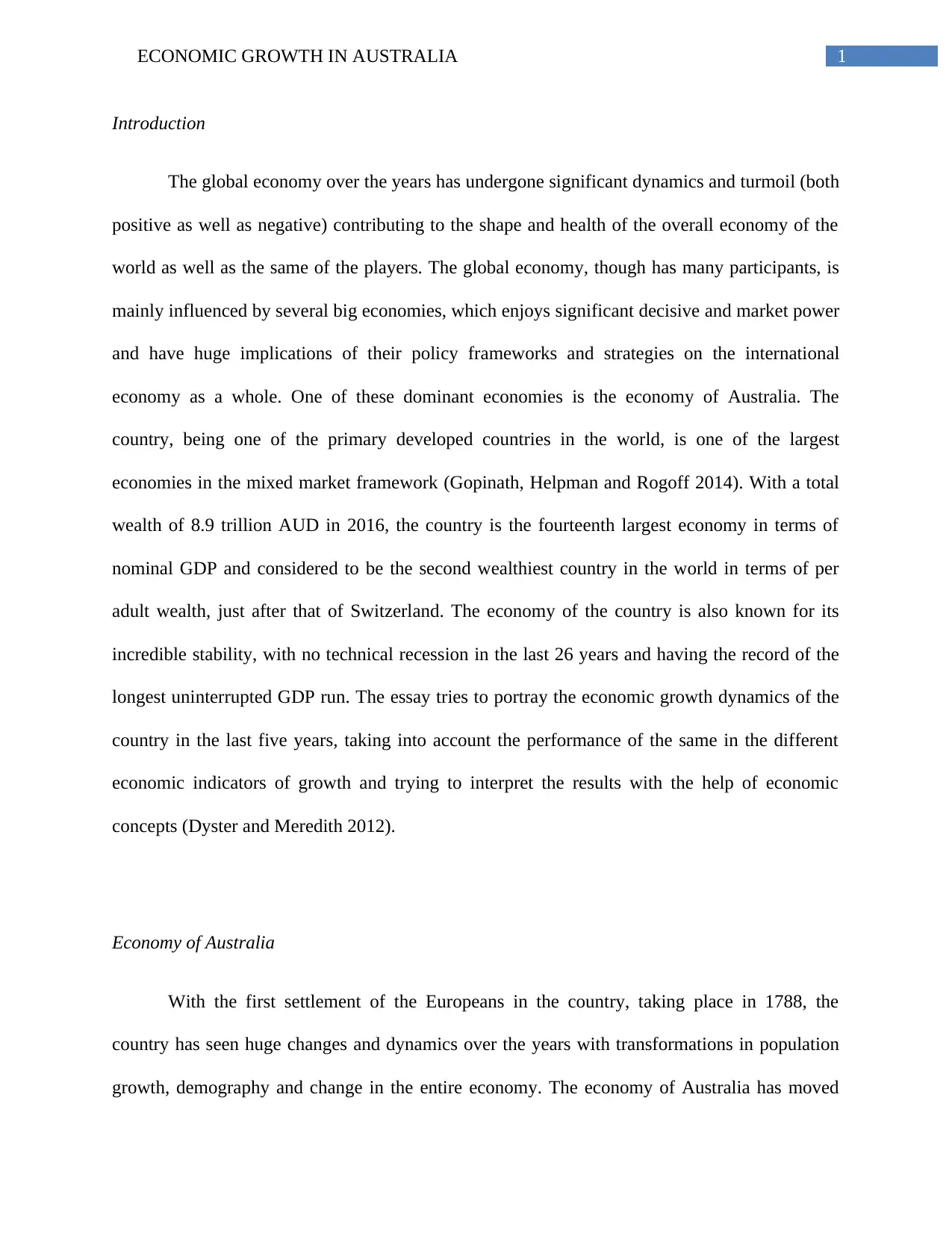
1ECONOMIC GROWTH IN AUSTRALIA
Introduction
The global economy over the years has undergone significant dynamics and turmoil (both
positive as well as negative) contributing to the shape and health of the overall economy of the
world as well as the same of the players. The global economy, though has many participants, is
mainly influenced by several big economies, which enjoys significant decisive and market power
and have huge implications of their policy frameworks and strategies on the international
economy as a whole. One of these dominant economies is the economy of Australia. The
country, being one of the primary developed countries in the world, is one of the largest
economies in the mixed market framework (Gopinath, Helpman and Rogoff 2014). With a total
wealth of 8.9 trillion AUD in 2016, the country is the fourteenth largest economy in terms of
nominal GDP and considered to be the second wealthiest country in the world in terms of per
adult wealth, just after that of Switzerland. The economy of the country is also known for its
incredible stability, with no technical recession in the last 26 years and having the record of the
longest uninterrupted GDP run. The essay tries to portray the economic growth dynamics of the
country in the last five years, taking into account the performance of the same in the different
economic indicators of growth and trying to interpret the results with the help of economic
concepts (Dyster and Meredith 2012).
Economy of Australia
With the first settlement of the Europeans in the country, taking place in 1788, the
country has seen huge changes and dynamics over the years with transformations in population
growth, demography and change in the entire economy. The economy of Australia has moved
Introduction
The global economy over the years has undergone significant dynamics and turmoil (both
positive as well as negative) contributing to the shape and health of the overall economy of the
world as well as the same of the players. The global economy, though has many participants, is
mainly influenced by several big economies, which enjoys significant decisive and market power
and have huge implications of their policy frameworks and strategies on the international
economy as a whole. One of these dominant economies is the economy of Australia. The
country, being one of the primary developed countries in the world, is one of the largest
economies in the mixed market framework (Gopinath, Helpman and Rogoff 2014). With a total
wealth of 8.9 trillion AUD in 2016, the country is the fourteenth largest economy in terms of
nominal GDP and considered to be the second wealthiest country in the world in terms of per
adult wealth, just after that of Switzerland. The economy of the country is also known for its
incredible stability, with no technical recession in the last 26 years and having the record of the
longest uninterrupted GDP run. The essay tries to portray the economic growth dynamics of the
country in the last five years, taking into account the performance of the same in the different
economic indicators of growth and trying to interpret the results with the help of economic
concepts (Dyster and Meredith 2012).
Economy of Australia
With the first settlement of the Europeans in the country, taking place in 1788, the
country has seen huge changes and dynamics over the years with transformations in population
growth, demography and change in the entire economy. The economy of Australia has moved
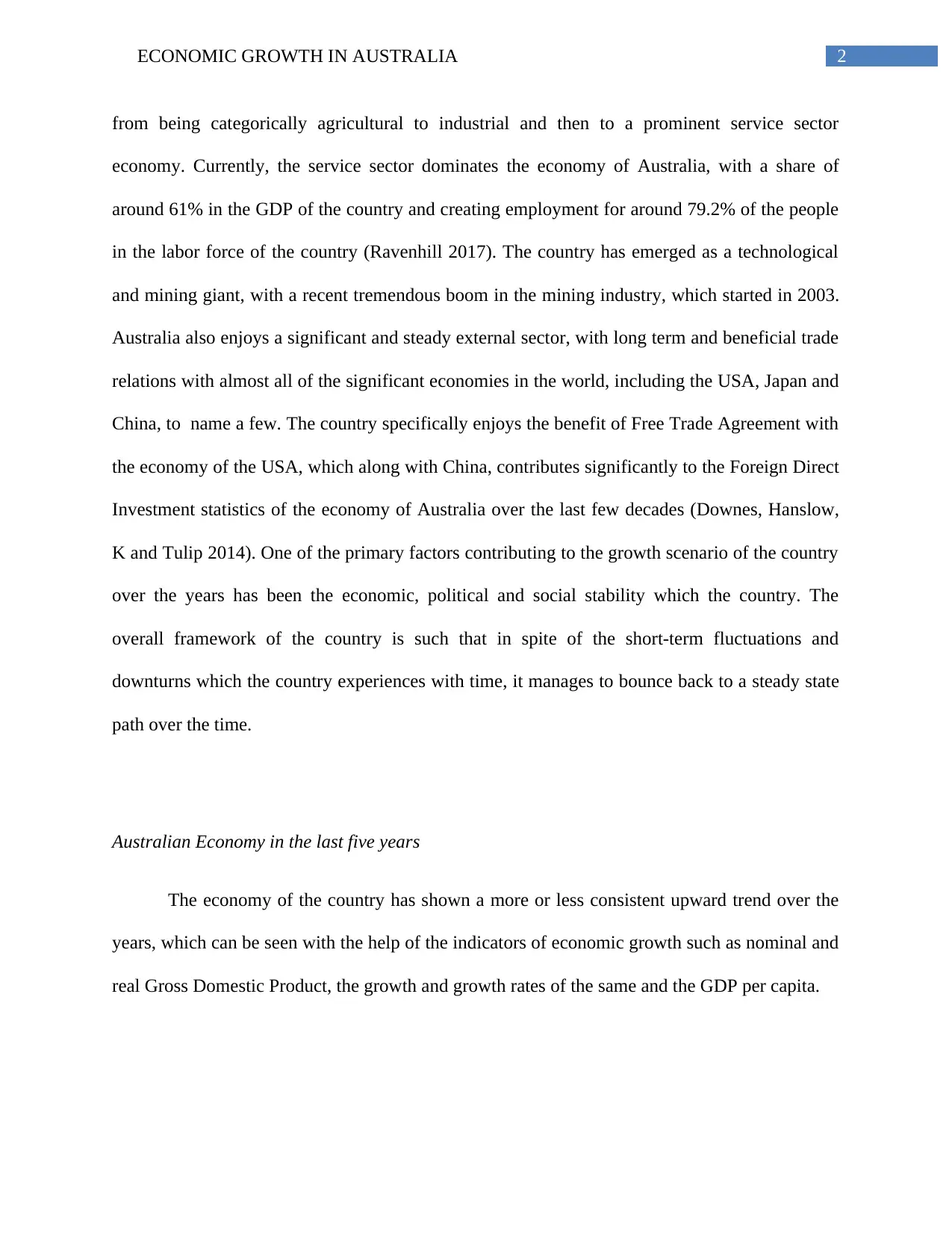
2ECONOMIC GROWTH IN AUSTRALIA
from being categorically agricultural to industrial and then to a prominent service sector
economy. Currently, the service sector dominates the economy of Australia, with a share of
around 61% in the GDP of the country and creating employment for around 79.2% of the people
in the labor force of the country (Ravenhill 2017). The country has emerged as a technological
and mining giant, with a recent tremendous boom in the mining industry, which started in 2003.
Australia also enjoys a significant and steady external sector, with long term and beneficial trade
relations with almost all of the significant economies in the world, including the USA, Japan and
China, to name a few. The country specifically enjoys the benefit of Free Trade Agreement with
the economy of the USA, which along with China, contributes significantly to the Foreign Direct
Investment statistics of the economy of Australia over the last few decades (Downes, Hanslow,
K and Tulip 2014). One of the primary factors contributing to the growth scenario of the country
over the years has been the economic, political and social stability which the country. The
overall framework of the country is such that in spite of the short-term fluctuations and
downturns which the country experiences with time, it manages to bounce back to a steady state
path over the time.
Australian Economy in the last five years
The economy of the country has shown a more or less consistent upward trend over the
years, which can be seen with the help of the indicators of economic growth such as nominal and
real Gross Domestic Product, the growth and growth rates of the same and the GDP per capita.
from being categorically agricultural to industrial and then to a prominent service sector
economy. Currently, the service sector dominates the economy of Australia, with a share of
around 61% in the GDP of the country and creating employment for around 79.2% of the people
in the labor force of the country (Ravenhill 2017). The country has emerged as a technological
and mining giant, with a recent tremendous boom in the mining industry, which started in 2003.
Australia also enjoys a significant and steady external sector, with long term and beneficial trade
relations with almost all of the significant economies in the world, including the USA, Japan and
China, to name a few. The country specifically enjoys the benefit of Free Trade Agreement with
the economy of the USA, which along with China, contributes significantly to the Foreign Direct
Investment statistics of the economy of Australia over the last few decades (Downes, Hanslow,
K and Tulip 2014). One of the primary factors contributing to the growth scenario of the country
over the years has been the economic, political and social stability which the country. The
overall framework of the country is such that in spite of the short-term fluctuations and
downturns which the country experiences with time, it manages to bounce back to a steady state
path over the time.
Australian Economy in the last five years
The economy of the country has shown a more or less consistent upward trend over the
years, which can be seen with the help of the indicators of economic growth such as nominal and
real Gross Domestic Product, the growth and growth rates of the same and the GDP per capita.
⊘ This is a preview!⊘
Do you want full access?
Subscribe today to unlock all pages.

Trusted by 1+ million students worldwide
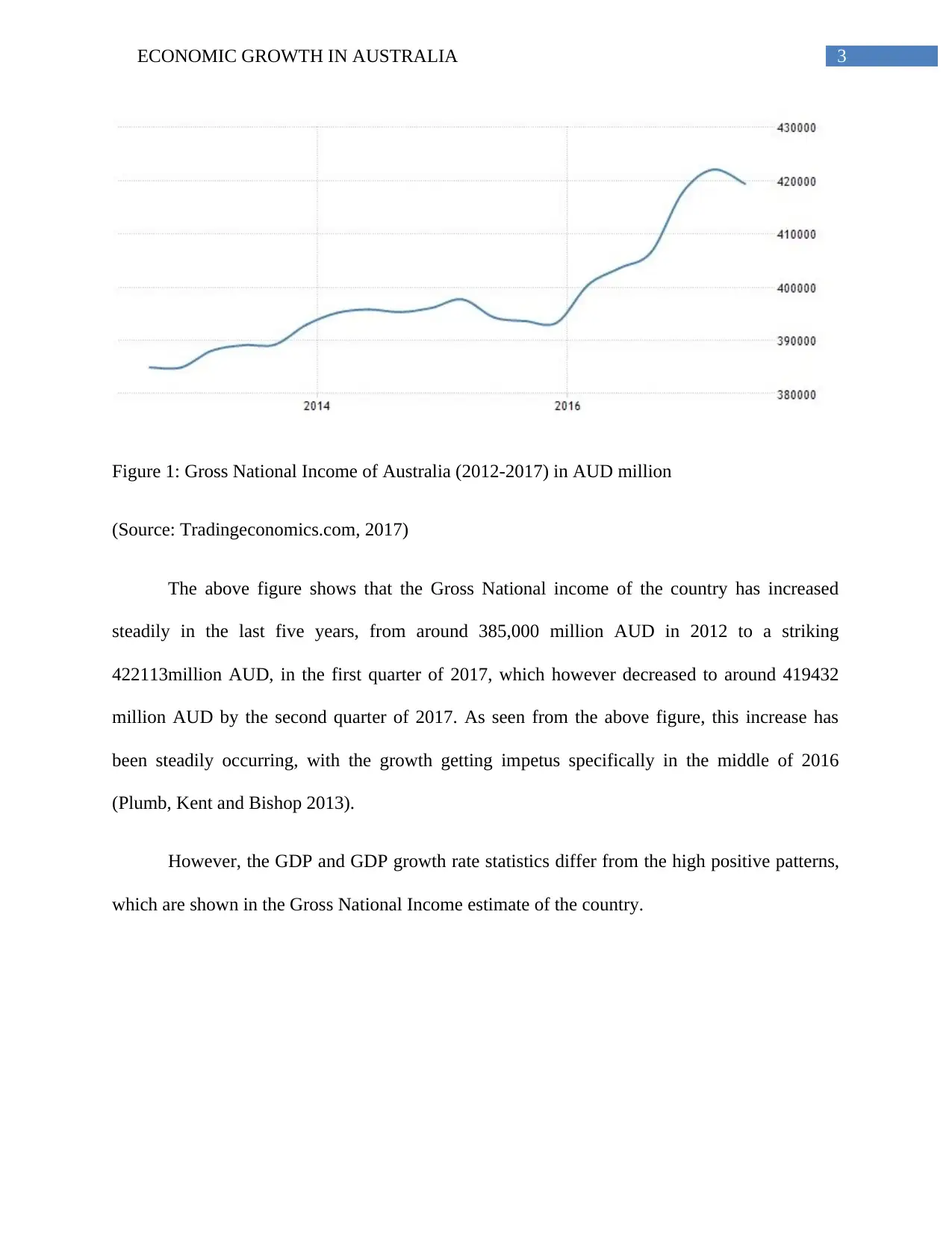
3ECONOMIC GROWTH IN AUSTRALIA
Figure 1: Gross National Income of Australia (2012-2017) in AUD million
(Source: Tradingeconomics.com, 2017)
The above figure shows that the Gross National income of the country has increased
steadily in the last five years, from around 385,000 million AUD in 2012 to a striking
422113million AUD, in the first quarter of 2017, which however decreased to around 419432
million AUD by the second quarter of 2017. As seen from the above figure, this increase has
been steadily occurring, with the growth getting impetus specifically in the middle of 2016
(Plumb, Kent and Bishop 2013).
However, the GDP and GDP growth rate statistics differ from the high positive patterns,
which are shown in the Gross National Income estimate of the country.
Figure 1: Gross National Income of Australia (2012-2017) in AUD million
(Source: Tradingeconomics.com, 2017)
The above figure shows that the Gross National income of the country has increased
steadily in the last five years, from around 385,000 million AUD in 2012 to a striking
422113million AUD, in the first quarter of 2017, which however decreased to around 419432
million AUD by the second quarter of 2017. As seen from the above figure, this increase has
been steadily occurring, with the growth getting impetus specifically in the middle of 2016
(Plumb, Kent and Bishop 2013).
However, the GDP and GDP growth rate statistics differ from the high positive patterns,
which are shown in the Gross National Income estimate of the country.
Paraphrase This Document
Need a fresh take? Get an instant paraphrase of this document with our AI Paraphraser
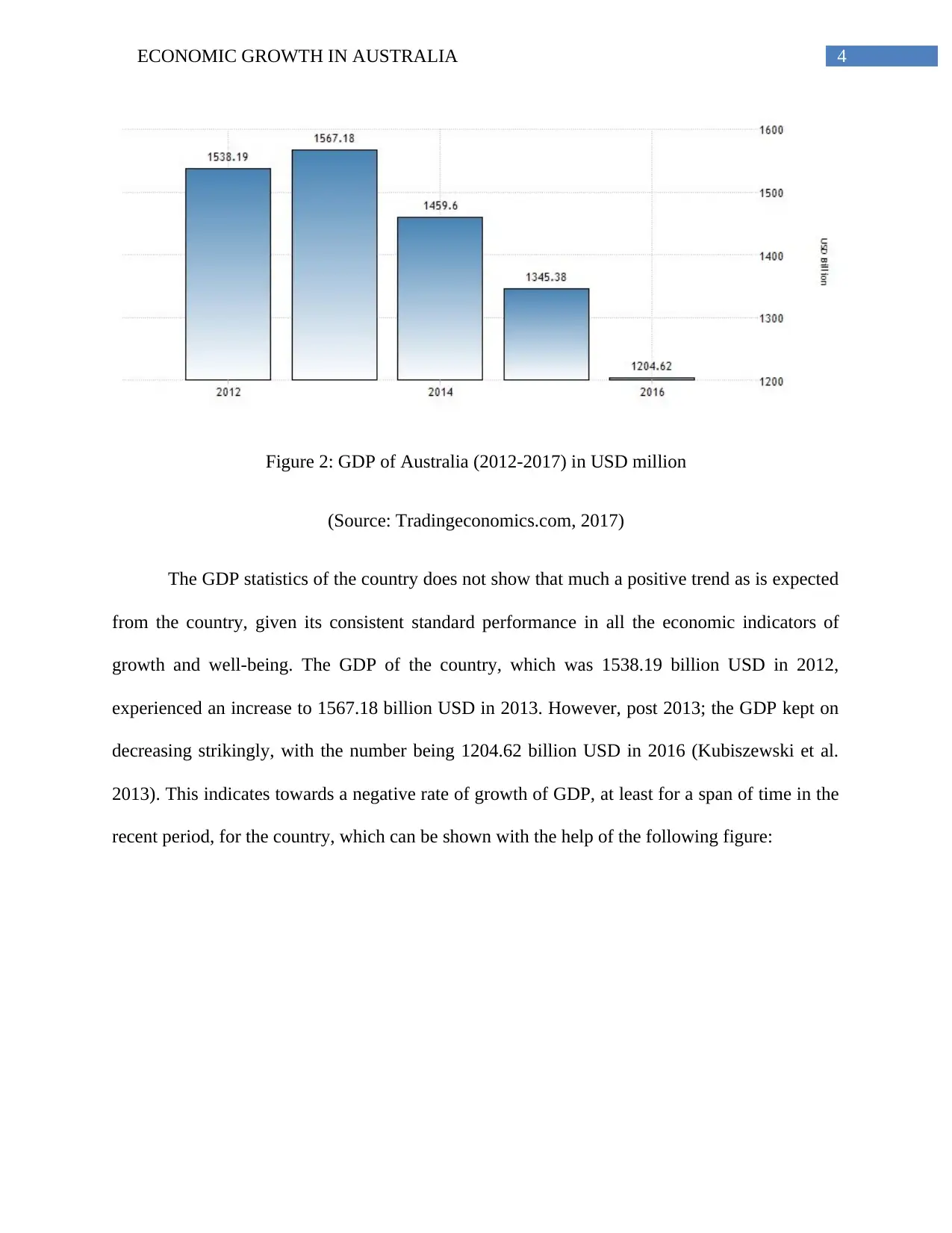
4ECONOMIC GROWTH IN AUSTRALIA
Figure 2: GDP of Australia (2012-2017) in USD million
(Source: Tradingeconomics.com, 2017)
The GDP statistics of the country does not show that much a positive trend as is expected
from the country, given its consistent standard performance in all the economic indicators of
growth and well-being. The GDP of the country, which was 1538.19 billion USD in 2012,
experienced an increase to 1567.18 billion USD in 2013. However, post 2013; the GDP kept on
decreasing strikingly, with the number being 1204.62 billion USD in 2016 (Kubiszewski et al.
2013). This indicates towards a negative rate of growth of GDP, at least for a span of time in the
recent period, for the country, which can be shown with the help of the following figure:
Figure 2: GDP of Australia (2012-2017) in USD million
(Source: Tradingeconomics.com, 2017)
The GDP statistics of the country does not show that much a positive trend as is expected
from the country, given its consistent standard performance in all the economic indicators of
growth and well-being. The GDP of the country, which was 1538.19 billion USD in 2012,
experienced an increase to 1567.18 billion USD in 2013. However, post 2013; the GDP kept on
decreasing strikingly, with the number being 1204.62 billion USD in 2016 (Kubiszewski et al.
2013). This indicates towards a negative rate of growth of GDP, at least for a span of time in the
recent period, for the country, which can be shown with the help of the following figure:
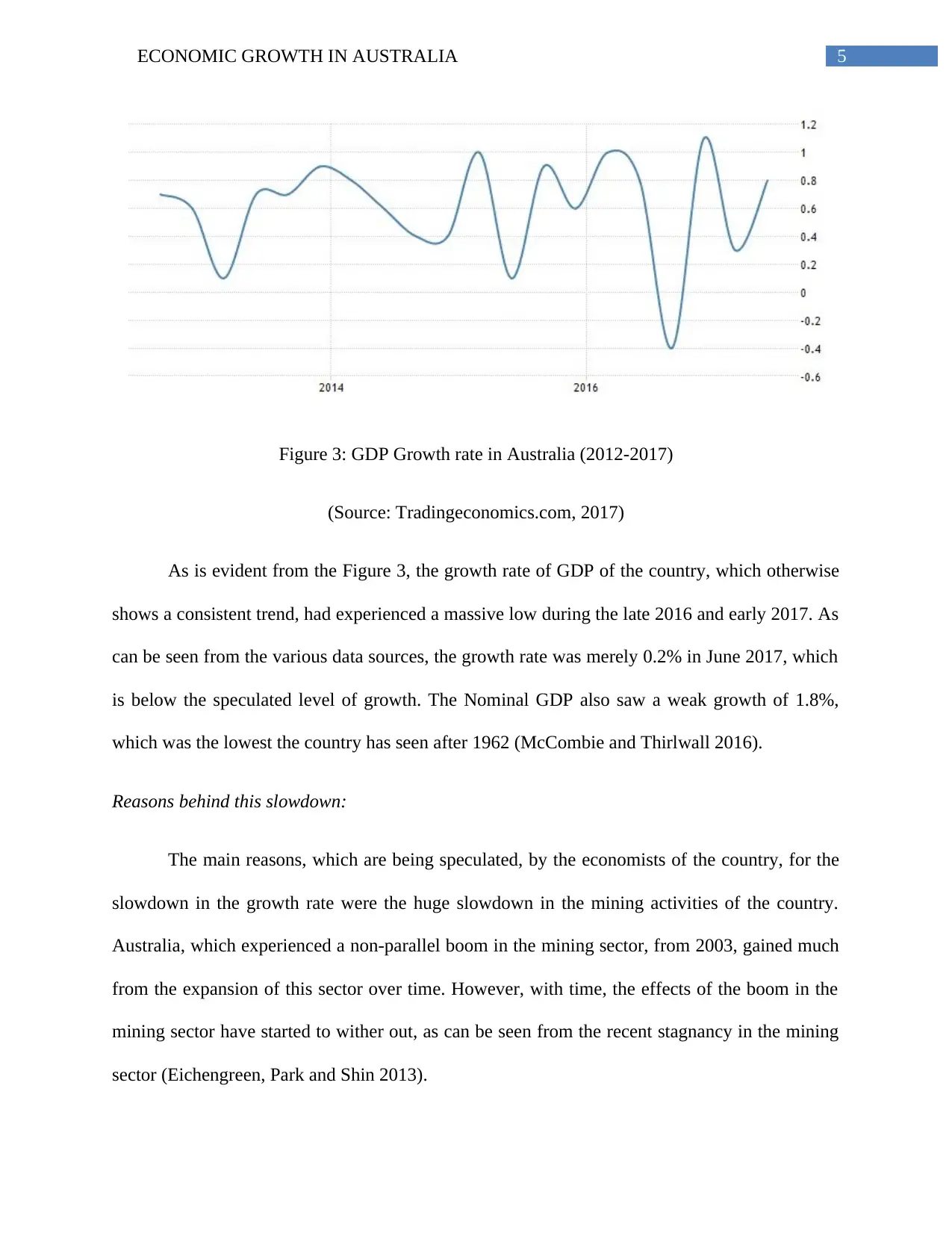
5ECONOMIC GROWTH IN AUSTRALIA
Figure 3: GDP Growth rate in Australia (2012-2017)
(Source: Tradingeconomics.com, 2017)
As is evident from the Figure 3, the growth rate of GDP of the country, which otherwise
shows a consistent trend, had experienced a massive low during the late 2016 and early 2017. As
can be seen from the various data sources, the growth rate was merely 0.2% in June 2017, which
is below the speculated level of growth. The Nominal GDP also saw a weak growth of 1.8%,
which was the lowest the country has seen after 1962 (McCombie and Thirlwall 2016).
Reasons behind this slowdown:
The main reasons, which are being speculated, by the economists of the country, for the
slowdown in the growth rate were the huge slowdown in the mining activities of the country.
Australia, which experienced a non-parallel boom in the mining sector, from 2003, gained much
from the expansion of this sector over time. However, with time, the effects of the boom in the
mining sector have started to wither out, as can be seen from the recent stagnancy in the mining
sector (Eichengreen, Park and Shin 2013).
Figure 3: GDP Growth rate in Australia (2012-2017)
(Source: Tradingeconomics.com, 2017)
As is evident from the Figure 3, the growth rate of GDP of the country, which otherwise
shows a consistent trend, had experienced a massive low during the late 2016 and early 2017. As
can be seen from the various data sources, the growth rate was merely 0.2% in June 2017, which
is below the speculated level of growth. The Nominal GDP also saw a weak growth of 1.8%,
which was the lowest the country has seen after 1962 (McCombie and Thirlwall 2016).
Reasons behind this slowdown:
The main reasons, which are being speculated, by the economists of the country, for the
slowdown in the growth rate were the huge slowdown in the mining activities of the country.
Australia, which experienced a non-parallel boom in the mining sector, from 2003, gained much
from the expansion of this sector over time. However, with time, the effects of the boom in the
mining sector have started to wither out, as can be seen from the recent stagnancy in the mining
sector (Eichengreen, Park and Shin 2013).
⊘ This is a preview!⊘
Do you want full access?
Subscribe today to unlock all pages.

Trusted by 1+ million students worldwide
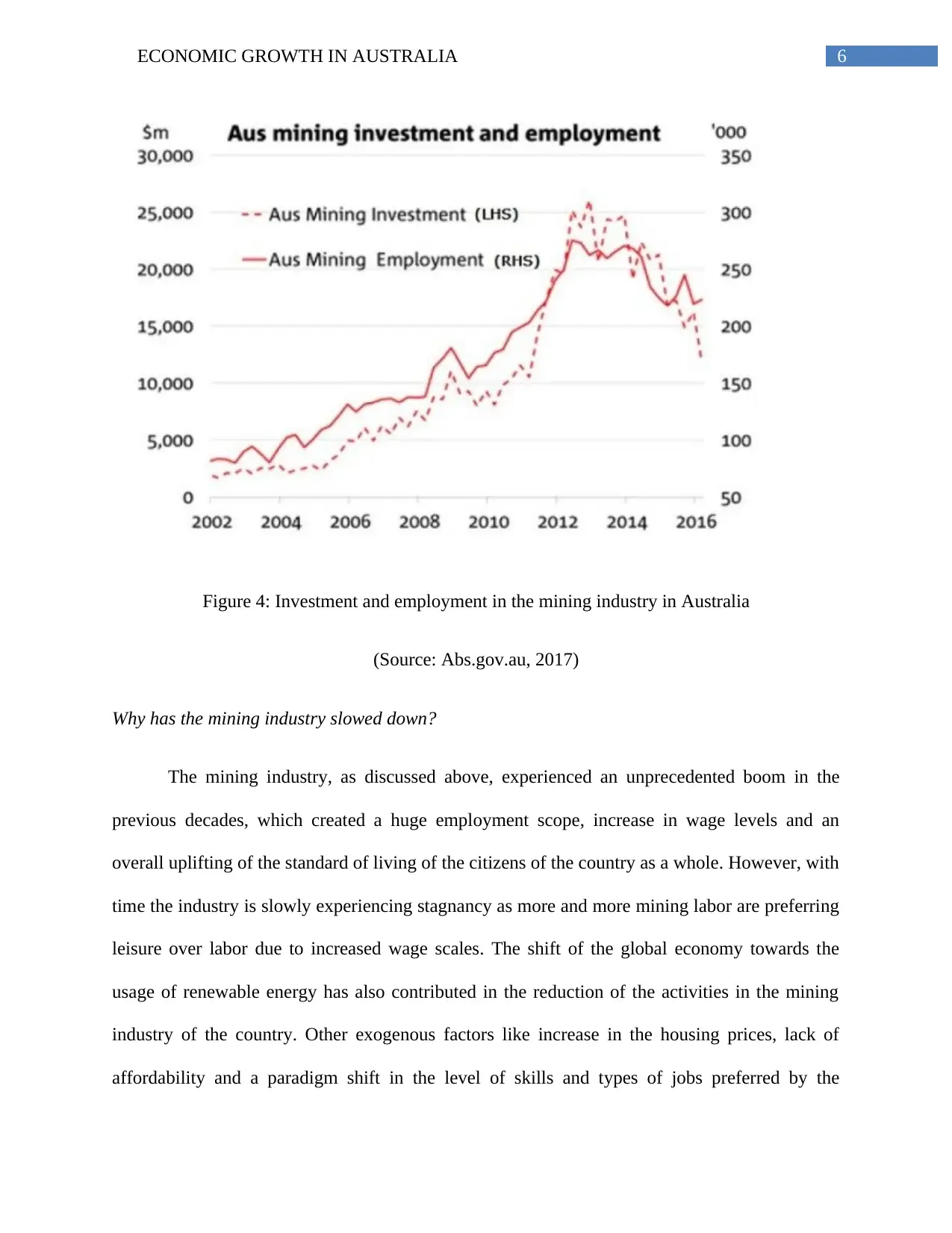
6ECONOMIC GROWTH IN AUSTRALIA
Figure 4: Investment and employment in the mining industry in Australia
(Source: Abs.gov.au, 2017)
Why has the mining industry slowed down?
The mining industry, as discussed above, experienced an unprecedented boom in the
previous decades, which created a huge employment scope, increase in wage levels and an
overall uplifting of the standard of living of the citizens of the country as a whole. However, with
time the industry is slowly experiencing stagnancy as more and more mining labor are preferring
leisure over labor due to increased wage scales. The shift of the global economy towards the
usage of renewable energy has also contributed in the reduction of the activities in the mining
industry of the country. Other exogenous factors like increase in the housing prices, lack of
affordability and a paradigm shift in the level of skills and types of jobs preferred by the
Figure 4: Investment and employment in the mining industry in Australia
(Source: Abs.gov.au, 2017)
Why has the mining industry slowed down?
The mining industry, as discussed above, experienced an unprecedented boom in the
previous decades, which created a huge employment scope, increase in wage levels and an
overall uplifting of the standard of living of the citizens of the country as a whole. However, with
time the industry is slowly experiencing stagnancy as more and more mining labor are preferring
leisure over labor due to increased wage scales. The shift of the global economy towards the
usage of renewable energy has also contributed in the reduction of the activities in the mining
industry of the country. Other exogenous factors like increase in the housing prices, lack of
affordability and a paradigm shift in the level of skills and types of jobs preferred by the
Paraphrase This Document
Need a fresh take? Get an instant paraphrase of this document with our AI Paraphraser
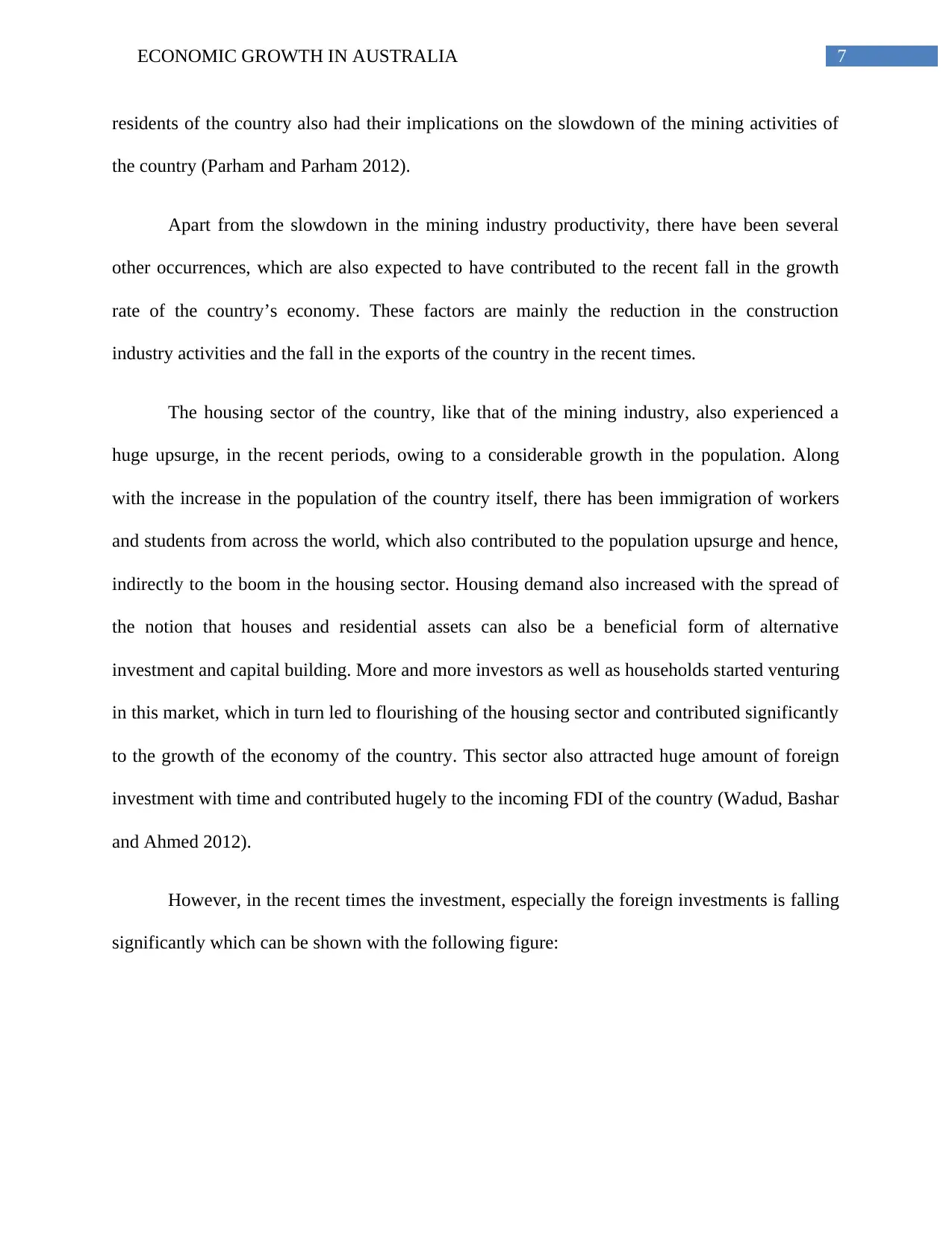
7ECONOMIC GROWTH IN AUSTRALIA
residents of the country also had their implications on the slowdown of the mining activities of
the country (Parham and Parham 2012).
Apart from the slowdown in the mining industry productivity, there have been several
other occurrences, which are also expected to have contributed to the recent fall in the growth
rate of the country’s economy. These factors are mainly the reduction in the construction
industry activities and the fall in the exports of the country in the recent times.
The housing sector of the country, like that of the mining industry, also experienced a
huge upsurge, in the recent periods, owing to a considerable growth in the population. Along
with the increase in the population of the country itself, there has been immigration of workers
and students from across the world, which also contributed to the population upsurge and hence,
indirectly to the boom in the housing sector. Housing demand also increased with the spread of
the notion that houses and residential assets can also be a beneficial form of alternative
investment and capital building. More and more investors as well as households started venturing
in this market, which in turn led to flourishing of the housing sector and contributed significantly
to the growth of the economy of the country. This sector also attracted huge amount of foreign
investment with time and contributed hugely to the incoming FDI of the country (Wadud, Bashar
and Ahmed 2012).
However, in the recent times the investment, especially the foreign investments is falling
significantly which can be shown with the following figure:
residents of the country also had their implications on the slowdown of the mining activities of
the country (Parham and Parham 2012).
Apart from the slowdown in the mining industry productivity, there have been several
other occurrences, which are also expected to have contributed to the recent fall in the growth
rate of the country’s economy. These factors are mainly the reduction in the construction
industry activities and the fall in the exports of the country in the recent times.
The housing sector of the country, like that of the mining industry, also experienced a
huge upsurge, in the recent periods, owing to a considerable growth in the population. Along
with the increase in the population of the country itself, there has been immigration of workers
and students from across the world, which also contributed to the population upsurge and hence,
indirectly to the boom in the housing sector. Housing demand also increased with the spread of
the notion that houses and residential assets can also be a beneficial form of alternative
investment and capital building. More and more investors as well as households started venturing
in this market, which in turn led to flourishing of the housing sector and contributed significantly
to the growth of the economy of the country. This sector also attracted huge amount of foreign
investment with time and contributed hugely to the incoming FDI of the country (Wadud, Bashar
and Ahmed 2012).
However, in the recent times the investment, especially the foreign investments is falling
significantly which can be shown with the following figure:
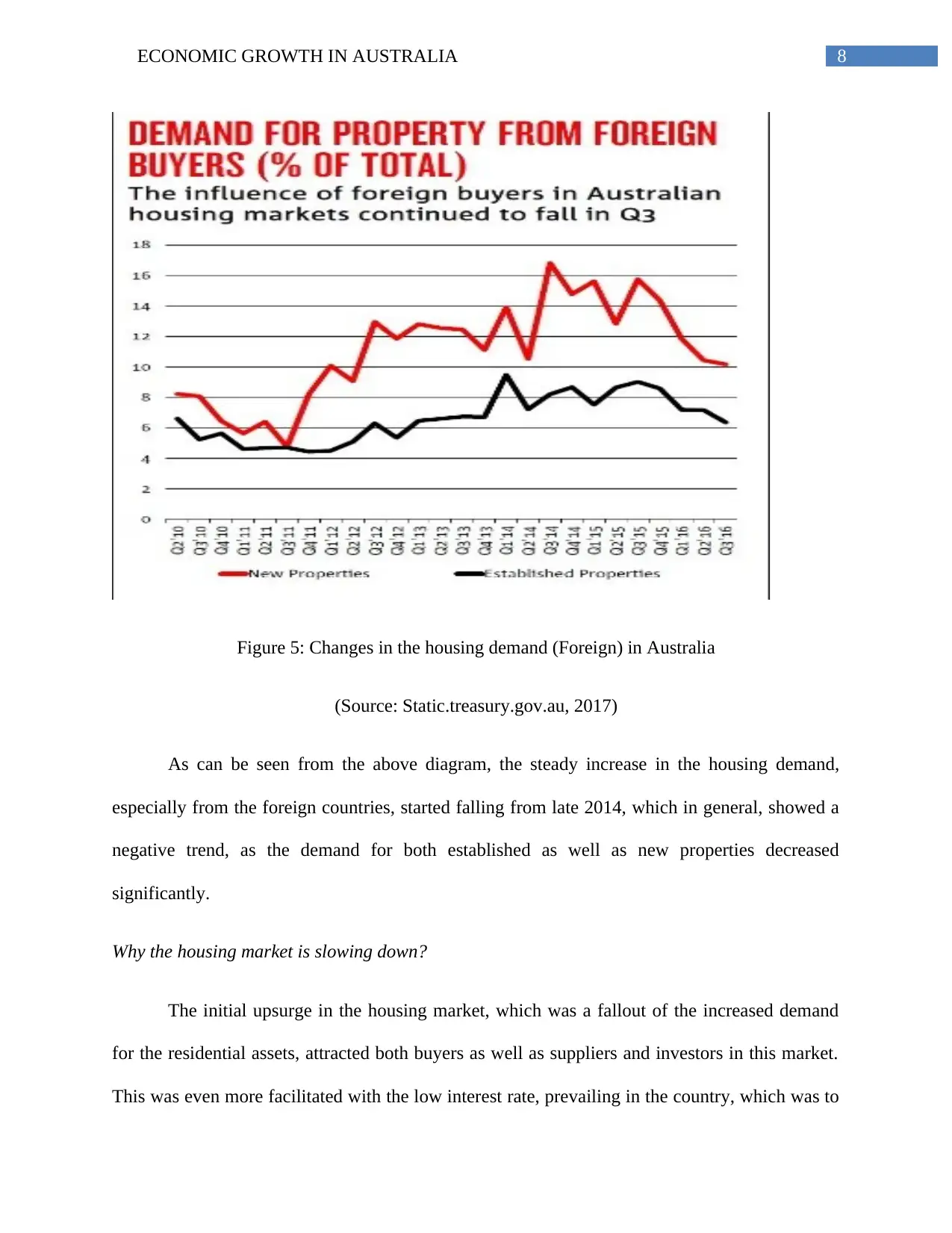
8ECONOMIC GROWTH IN AUSTRALIA
Figure 5: Changes in the housing demand (Foreign) in Australia
(Source: Static.treasury.gov.au, 2017)
As can be seen from the above diagram, the steady increase in the housing demand,
especially from the foreign countries, started falling from late 2014, which in general, showed a
negative trend, as the demand for both established as well as new properties decreased
significantly.
Why the housing market is slowing down?
The initial upsurge in the housing market, which was a fallout of the increased demand
for the residential assets, attracted both buyers as well as suppliers and investors in this market.
This was even more facilitated with the low interest rate, prevailing in the country, which was to
Figure 5: Changes in the housing demand (Foreign) in Australia
(Source: Static.treasury.gov.au, 2017)
As can be seen from the above diagram, the steady increase in the housing demand,
especially from the foreign countries, started falling from late 2014, which in general, showed a
negative trend, as the demand for both established as well as new properties decreased
significantly.
Why the housing market is slowing down?
The initial upsurge in the housing market, which was a fallout of the increased demand
for the residential assets, attracted both buyers as well as suppliers and investors in this market.
This was even more facilitated with the low interest rate, prevailing in the country, which was to
⊘ This is a preview!⊘
Do you want full access?
Subscribe today to unlock all pages.

Trusted by 1+ million students worldwide
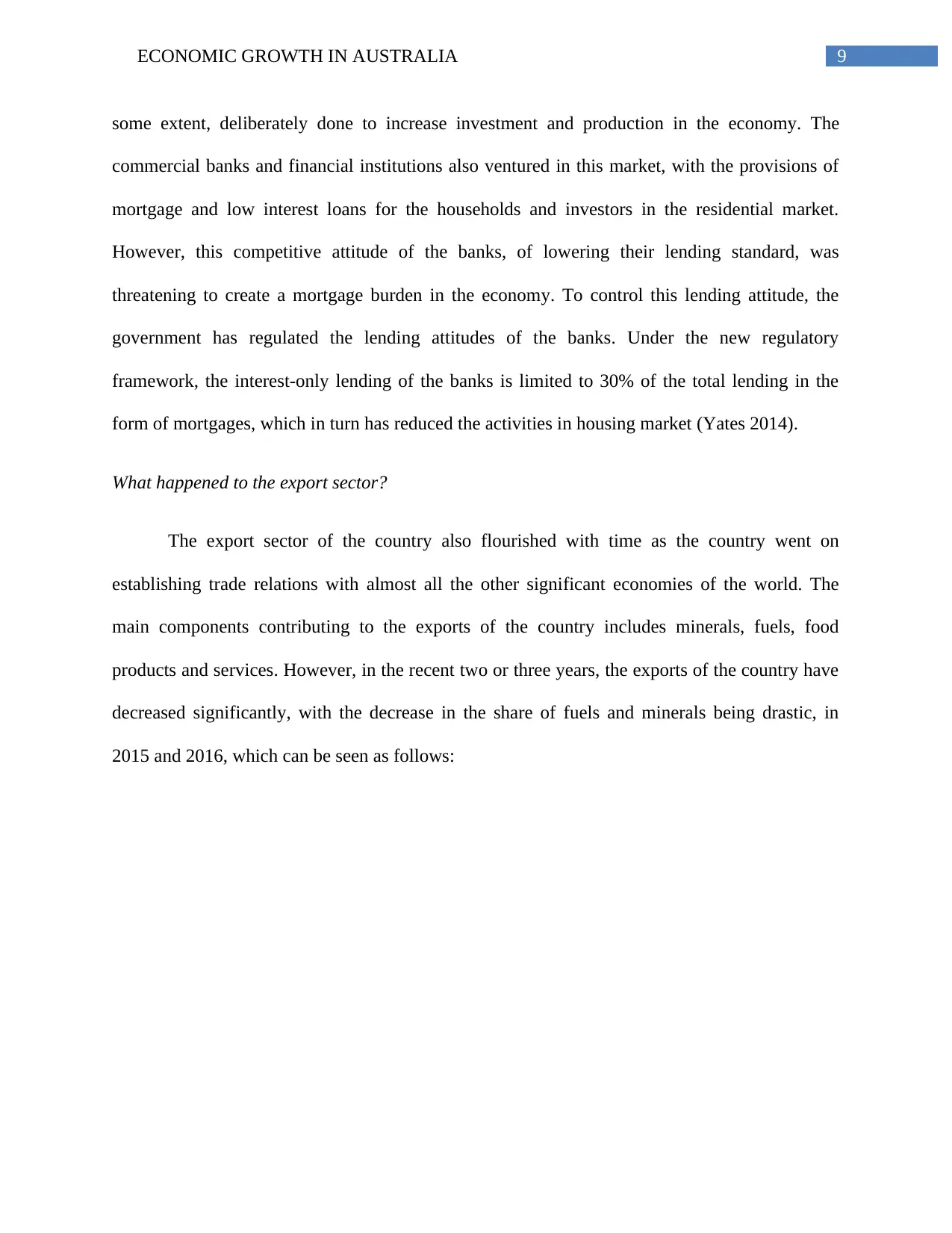
9ECONOMIC GROWTH IN AUSTRALIA
some extent, deliberately done to increase investment and production in the economy. The
commercial banks and financial institutions also ventured in this market, with the provisions of
mortgage and low interest loans for the households and investors in the residential market.
However, this competitive attitude of the banks, of lowering their lending standard, was
threatening to create a mortgage burden in the economy. To control this lending attitude, the
government has regulated the lending attitudes of the banks. Under the new regulatory
framework, the interest-only lending of the banks is limited to 30% of the total lending in the
form of mortgages, which in turn has reduced the activities in housing market (Yates 2014).
What happened to the export sector?
The export sector of the country also flourished with time as the country went on
establishing trade relations with almost all the other significant economies of the world. The
main components contributing to the exports of the country includes minerals, fuels, food
products and services. However, in the recent two or three years, the exports of the country have
decreased significantly, with the decrease in the share of fuels and minerals being drastic, in
2015 and 2016, which can be seen as follows:
some extent, deliberately done to increase investment and production in the economy. The
commercial banks and financial institutions also ventured in this market, with the provisions of
mortgage and low interest loans for the households and investors in the residential market.
However, this competitive attitude of the banks, of lowering their lending standard, was
threatening to create a mortgage burden in the economy. To control this lending attitude, the
government has regulated the lending attitudes of the banks. Under the new regulatory
framework, the interest-only lending of the banks is limited to 30% of the total lending in the
form of mortgages, which in turn has reduced the activities in housing market (Yates 2014).
What happened to the export sector?
The export sector of the country also flourished with time as the country went on
establishing trade relations with almost all the other significant economies of the world. The
main components contributing to the exports of the country includes minerals, fuels, food
products and services. However, in the recent two or three years, the exports of the country have
decreased significantly, with the decrease in the share of fuels and minerals being drastic, in
2015 and 2016, which can be seen as follows:
Paraphrase This Document
Need a fresh take? Get an instant paraphrase of this document with our AI Paraphraser
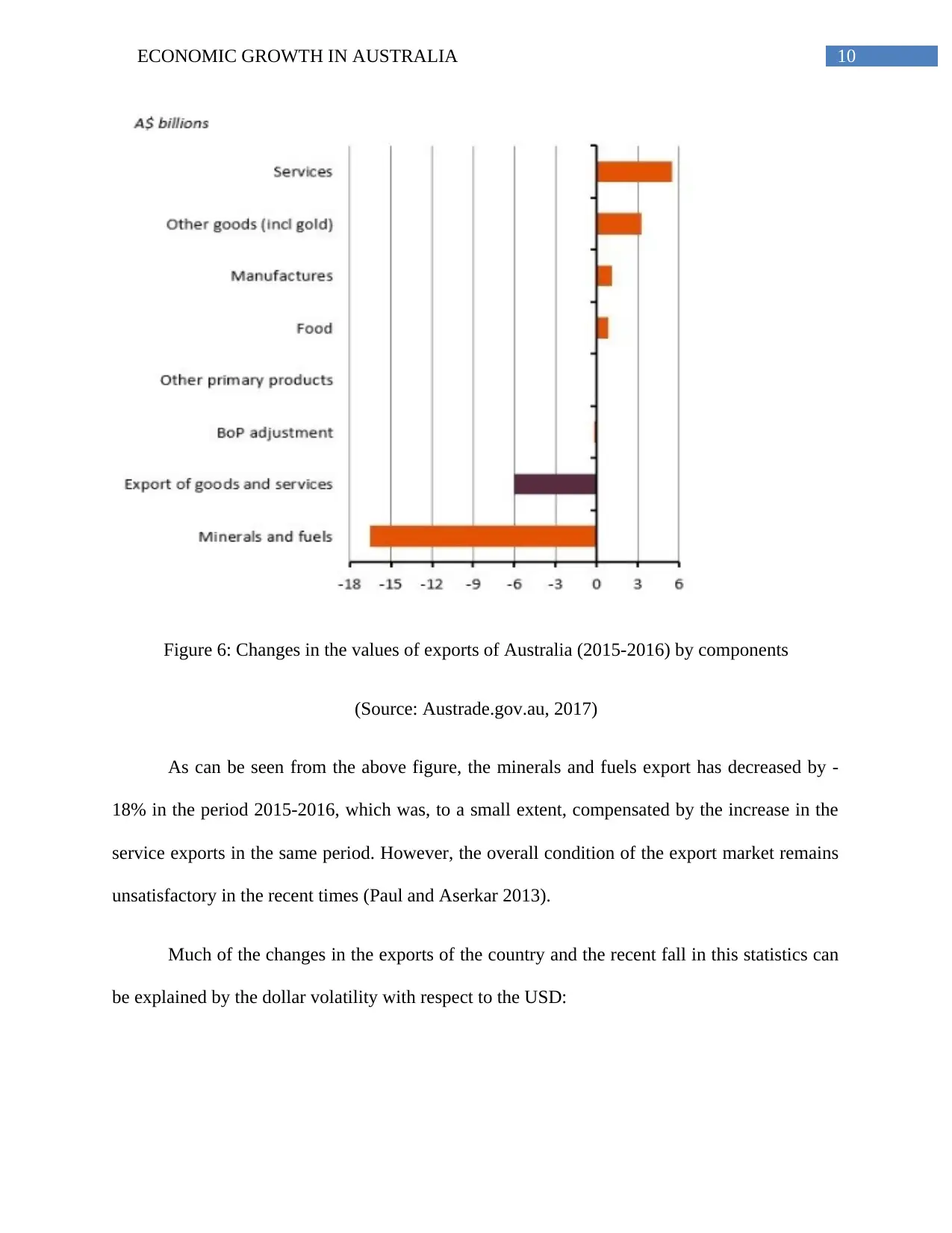
10ECONOMIC GROWTH IN AUSTRALIA
Figure 6: Changes in the values of exports of Australia (2015-2016) by components
(Source: Austrade.gov.au, 2017)
As can be seen from the above figure, the minerals and fuels export has decreased by -
18% in the period 2015-2016, which was, to a small extent, compensated by the increase in the
service exports in the same period. However, the overall condition of the export market remains
unsatisfactory in the recent times (Paul and Aserkar 2013).
Much of the changes in the exports of the country and the recent fall in this statistics can
be explained by the dollar volatility with respect to the USD:
Figure 6: Changes in the values of exports of Australia (2015-2016) by components
(Source: Austrade.gov.au, 2017)
As can be seen from the above figure, the minerals and fuels export has decreased by -
18% in the period 2015-2016, which was, to a small extent, compensated by the increase in the
service exports in the same period. However, the overall condition of the export market remains
unsatisfactory in the recent times (Paul and Aserkar 2013).
Much of the changes in the exports of the country and the recent fall in this statistics can
be explained by the dollar volatility with respect to the USD:
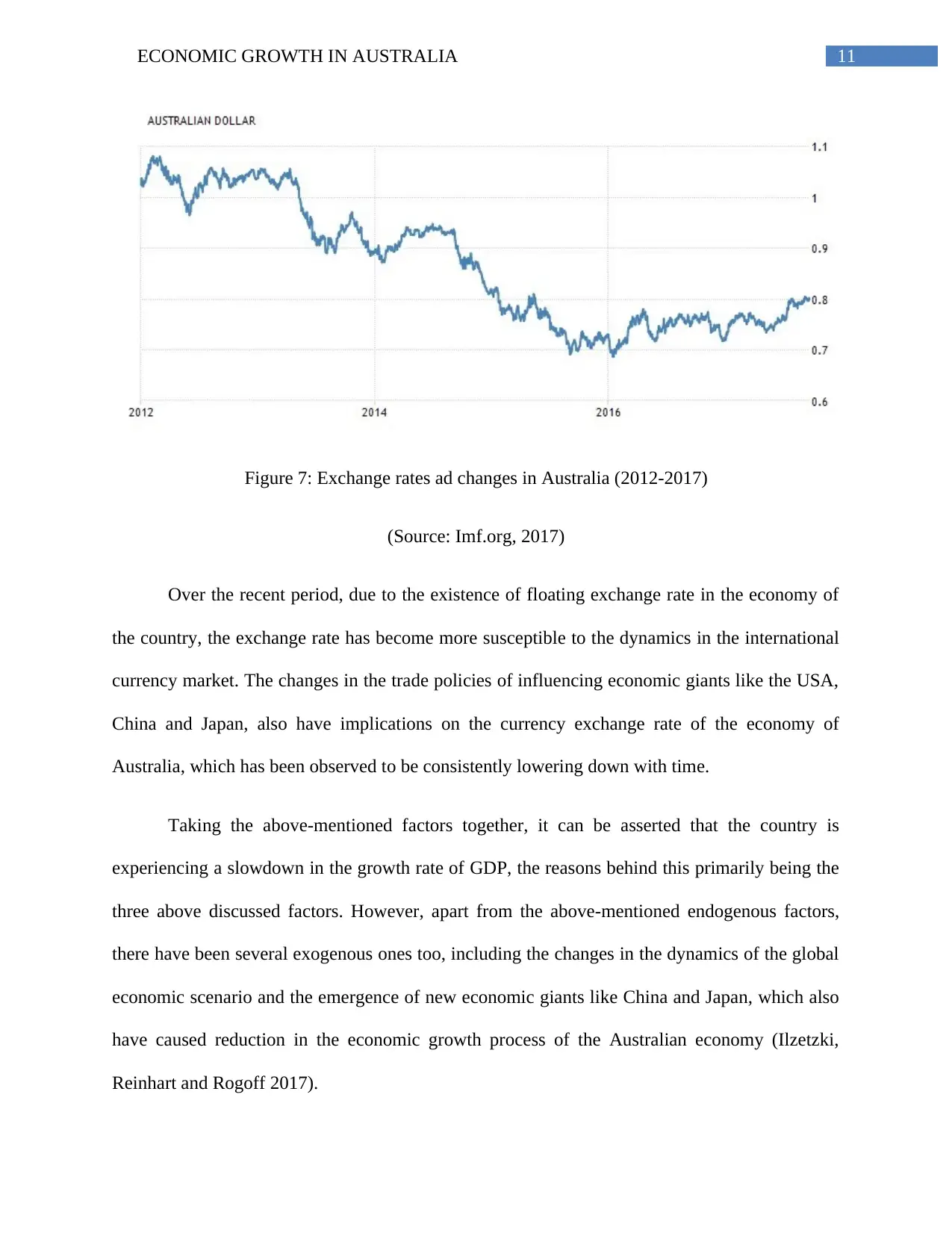
11ECONOMIC GROWTH IN AUSTRALIA
Figure 7: Exchange rates ad changes in Australia (2012-2017)
(Source: Imf.org, 2017)
Over the recent period, due to the existence of floating exchange rate in the economy of
the country, the exchange rate has become more susceptible to the dynamics in the international
currency market. The changes in the trade policies of influencing economic giants like the USA,
China and Japan, also have implications on the currency exchange rate of the economy of
Australia, which has been observed to be consistently lowering down with time.
Taking the above-mentioned factors together, it can be asserted that the country is
experiencing a slowdown in the growth rate of GDP, the reasons behind this primarily being the
three above discussed factors. However, apart from the above-mentioned endogenous factors,
there have been several exogenous ones too, including the changes in the dynamics of the global
economic scenario and the emergence of new economic giants like China and Japan, which also
have caused reduction in the economic growth process of the Australian economy (Ilzetzki,
Reinhart and Rogoff 2017).
Figure 7: Exchange rates ad changes in Australia (2012-2017)
(Source: Imf.org, 2017)
Over the recent period, due to the existence of floating exchange rate in the economy of
the country, the exchange rate has become more susceptible to the dynamics in the international
currency market. The changes in the trade policies of influencing economic giants like the USA,
China and Japan, also have implications on the currency exchange rate of the economy of
Australia, which has been observed to be consistently lowering down with time.
Taking the above-mentioned factors together, it can be asserted that the country is
experiencing a slowdown in the growth rate of GDP, the reasons behind this primarily being the
three above discussed factors. However, apart from the above-mentioned endogenous factors,
there have been several exogenous ones too, including the changes in the dynamics of the global
economic scenario and the emergence of new economic giants like China and Japan, which also
have caused reduction in the economic growth process of the Australian economy (Ilzetzki,
Reinhart and Rogoff 2017).
⊘ This is a preview!⊘
Do you want full access?
Subscribe today to unlock all pages.

Trusted by 1+ million students worldwide
1 out of 22
Related Documents
Your All-in-One AI-Powered Toolkit for Academic Success.
+13062052269
info@desklib.com
Available 24*7 on WhatsApp / Email
![[object Object]](/_next/static/media/star-bottom.7253800d.svg)
Unlock your academic potential
Copyright © 2020–2025 A2Z Services. All Rights Reserved. Developed and managed by ZUCOL.





